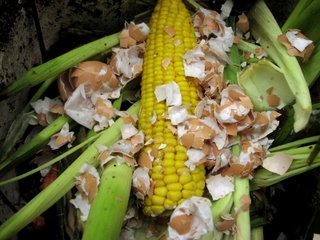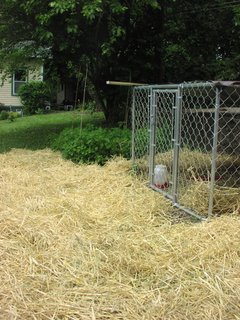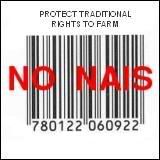COMPOST

COMPOST
Well enough of the cow themes for the while, though I was tempted to comment on the recent article today about Canada’s latest folly. I’m sure you’re all quite aware. I wanted to touch upon a subject that I’ve given a lot of attention to lately in my pursuits and endeavors. Some thing dear to my heart – compost. Recently while purveying a link over to Joel Salatin’s site, I was checking his reading list and came across a title that he gave high mention to, Permaculture: A Designers’ Manual by Bill Mollison. I’m sure several of you are familiar with his work & writings, for those who are not it would be time well spent researching some of his interviews and articles online.
Several months ago I acquired a few Red Wigglers from Acme Worm Farm (great folks!) with intent on the propagation of compost in hopes of learning more on soil make up and health. Having several “sick soils” when we first moved to this property, I decided to see if I could turn things around with out the dumping of chemicals or a large expenditure in top soil. Now granted when you talk soil, you talk chemistry, and it would be falsehood if I were to lead you to think there’s no science involved here or that it was some form of shamanism, gnomes or magical thinking. We just purposed that we wouldn’t dump synthetics on the soil, pesticides or weed killer to tame the lame, anemic earth. Heavy clays in which only the heartiest weeds and seeds survived, lack of nutrients and compression filled the forty, that was to be our backyard.
The first year was our garden tester, as we tilled up a third of the soil and laid in amaranth, tomatoes, and peppers hot & sweet. We planted grapes, beans and corn. Carrots were late and like the corn came to naught. Also note, the corn we planted the first year was GMO corn that was not even a “good mule”. Disappointed but not daunted, I tried again this year, to far better results – GMO FREE!
Now we have plated 80% of our soil to corn, pumpkins, tomatoes, potatoes, and grapes in the second year, cucumbers, lettuces and mangled beets. As well an assortment of flowers and fauna adorn the outer edges of our crops. We have soil enhancers operating under cover and producing 24/7 – our chickens & worms! I have three composting venues for our soils, plant matter, chicken manure and household disposal & vegetable matter which is feed direct to the “incubator” for the worms. One of the most prolific feeds or bedding starters for the red wigglers is shredded and soaked newspaper mixed with coffee grounds. I pulp the newsprint after soaking it for two to three days in a five gallon bucket of water with a stucco mixer on a portable drill. Gets it to the beginning of the break down cycle before introducing it to the worms. All this helps reduce the “trash” run we make to the dump. Most of what we produce in our household’s here in the US can follow the motto of “Reuse, Recycle, Reclaim”. It is the “Cult of Efficiency” motto or resulting actions to the proverb “Haste makes Waste”. Here in the US we are some ‘hasty folks’, aside from the ecological impact (of which we are aware but do little about as a country) the economic impact of waste is taking its toll as well. I am a conservative, not based out of any strong held political belief, but because I seek to live a life of conservation – economically as well as ecologically. It just makes sense.
Soil science, as Bill Mollison described “modern technological agriculture as a form of "witchcraft."
“Well, it is a sort of witchcraft. Today we have more soil scientists than at any other time in history. If you plot the rise of soil scientists against the loss of soil, you see that the more of them you have, the more soil you lose.”
“The important thing is not to do any agriculture whatsoever, and particularly to make the modern agricultural sciences a forbidden area - they're worse than witchcraft, really. The agriculture taught at colleges between 1930 and 1980 has caused more damage on the face of the Earth than any other factor. "Should we tamper with nature?" is no longer a question - we've tampered with nature on the whole face of the Earth."
"If you let the world roll on the way it's rolling, you're voting for death. I'm not voting for death. The extinction rate is so huge now; we're to the stage where we've got to set up recombinant ecologies. There are no longer enough species left, anywhere, to hold the system together. We have to let nature put what's left together, and see what it can come up with to save our ass.”
“The important thing is not to do any agriculture whatsoever, and particularly to make the modern agricultural sciences a forbidden area - they're worse than witchcraft, really. The agriculture taught at colleges between 1930 and 1980 has caused more damage on the face of the Earth than any other factor. "Should we tamper with nature?" is no longer a question - we've tampered with nature on the whole face of the Earth."
"If you let the world roll on the way it's rolling, you're voting for death. I'm not voting for death. The extinction rate is so huge now; we're to the stage where we've got to set up recombinant ecologies. There are no longer enough species left, anywhere, to hold the system together. We have to let nature put what's left together, and see what it can come up with to save our ass.”
Well, I suppose at times – you got to be blunt. He is an interesting read, and (as the English say) Spot On when it comes to ideas that work. I found my self somewhat slack jawed & excited at the same time as I read a few of his interviews. There are a few: Here, Here & Here. I hope you take the time to give them a read. As for me I’ll wait to report more as I acquire his book on permaculture - it’s a pricey read – so I’ll seek an alternative source first. If anyone has this title and would consider a barter/loan arrangement for say, a few pounds of fresh roasted coffee, please email me separately from my contact page.
WEEDS
Interestingly I have come to two personal discoveries this year in regards to “weeds” about my property – not all things are, as they first seem. First was Lambs Quarter – or bacon weed, fat hen, or white goosefoot. This pernicious weed plagued me & my garden the first year, then I saw a photo of it and learned it’s name. As well our Rhode Island Reds love it! (Here it is by the coop)

Turns out it is great form of “greens” for juicing and several other uses. (Little did I know) Here are some blog mentions of this “Green Gold”. (Here and Here) The second “weed” was one I hesitated to pull because I “saw it” somewhere before, so better wait on this “interesting” weed. Well turns out – good things come to ‘dem who wait!
Introducing our second “Mystery Weed”:
“Little Hogweed” or Purslane. Another “discovery” by the: none so smart (but ever patient) ardent agrarian as I will now encourage (though check) it’s growth and winter-ability indoors as well. Here is a blog post with some more information on it.
So now, as I remarked to my wife, as we look for more land, what I most want to take with me from this house we call home – Is The Weeds!
Interestingly I have come to two personal discoveries this year in regards to “weeds” about my property – not all things are, as they first seem. First was Lambs Quarter – or bacon weed, fat hen, or white goosefoot. This pernicious weed plagued me & my garden the first year, then I saw a photo of it and learned it’s name. As well our Rhode Island Reds love it! (Here it is by the coop)

Turns out it is great form of “greens” for juicing and several other uses. (Little did I know) Here are some blog mentions of this “Green Gold”. (Here and Here) The second “weed” was one I hesitated to pull because I “saw it” somewhere before, so better wait on this “interesting” weed. Well turns out – good things come to ‘dem who wait!
Introducing our second “Mystery Weed”:
“Little Hogweed” or Purslane. Another “discovery” by the: none so smart (but ever patient) ardent agrarian as I will now encourage (though check) it’s growth and winter-ability indoors as well. Here is a blog post with some more information on it.
So now, as I remarked to my wife, as we look for more land, what I most want to take with me from this house we call home – Is The Weeds!


7 Comments:
I haven't read the interviews yet, they're loading in another browers page now, but I don't like Bill Millson's idea of "stopping all agriculture". That is throwing the baby out with the bathwater. The reality is that a very few (the 5% who are big croppers, factory farms, feedlots, etc) are doing it wrong and doing a lot of destruction. They produce 85% of the food in America and possibly elsewhere. They also yield a tremendous and dispropotinate amount of power which is the whole problem with NAIS.
The other 95% of the agriculture is done on a far smaller scale and much of that is sustainable, organic, etc. Many of these farmers are actually improving their soil and water. We do. You too. The problem is the USDA and it's ilk listen to the economically powerful 5% who are abusing our planet.
The solution isn't to throw out the good with the bad by "stopping all agriculture" but rather to get consumers to support their local, small, sustainable producers and stop supporting the abusers. If we stop enabling them then they will stop abusing the land because it is not sustainable. The real costs of big-ag are much higher than they seem due to subsidies on oil and direct subsidies to big "farmers". Eliminate those and they will topple. Everyone will feel the pinch as the price of gasoline and diesel shoots up to $7 per gallon but perhaps that is what it will take to get people to take concervation seriously.
On another subject, you asked on Sugar Mountain Farm if I had ever considered fish farming. I've thought about it but not done anything with it - yet. Rather than raising trout, which I do plan to try, I'm actually more interested in cultivating corals and tropical marine fish. One might think that is a bit of an odd idea for someone living on a mountain in northern Vermont... But I have some ideas. :) More on that some other day.
"I haven't read the interviews yet, they're loading in another browsers page now, but I don't like Bill Millson's idea of "stopping all agriculture". That is throwing the baby out with the bathwater"
Agreed, I don't think you would find me a proponent of 'stopping all agriculture' either. Though I don't see that as his emphasis. In speaking about 'No Ag' I see (saw) his emphasis or focus as to "modern agricultural sciences". Though I can't support or defend that in it's entirety as I have not read his writings thoroughly, only the articles/interviews. What leads me to this preliminary conclusion is his timeframe reference of dates (1930 - 1980) a somewhat limited scope.
His ideas of “recombinant ecologies” are something I found of greater interest as it leads to what I was writing about regarding compost and soil health.
"The real costs of big-ag are much higher than they seem due to subsidies on oil and direct subsidies to big "farmers".
Agreed, subsidies & paybacks, something I've rallied around in addressing issues to the Ohio DOA regarding the raw milk issue, as in this letter to Melanie Wilt's remarks:
"The judge understands Ohio's dairy laws are there to protect consumers." said Melanie Wilt, spokeswoman for the agriculture department.
Yeah, I can't count the number of times I've meant to stop by the supermarket for some pasteurized Lawson's, and not noticed that I'd accidentally stumbled onto an Amish farm and was buying raw milk instead. It's a good thing state undercover agents are fighting to make this sort of disaster absolutely impossible.
Seems that your statements conflict with your primary mission statement?
"The mission of the Ohio Department of Agriculture is to provide regulatory protection to producers........" ['we are here from the government and we are here to help']
God helps us all!
Sincerely,
Scott A. Holtzman
Ps. CHEW ON THIS!
Because of the countries successful food production and distribution system the average American earns enough money in 40 working days to pay for a years worth of food. By contrast, it takes the average American 124 days to earn enough to pay federal, state, and local taxes for one year.
[Jee, thanks for the friendly reminder government agency that troddens the small farmer with no large corporate offerings to pay an inducement.]
Perhaps then you could return funds established by an act of Congress and shave off a day or two from that statistic?
The Chew On This, Factoid was from there own web site - pretty "boar-ish" if you ask me, no gilts there!
As to statistics, the 5% producing 85%, and 95% being the remains –small farmers (us) – I’d be interested where that static was derived from (source)? I’d like to incorporate it into some thing I’m writing, but wanted to confirm it’s validity. Thanks and well wishes!
I have no doubt that Walter is correct based on his experience where he lives. However, in the Corn Belt area where I live, even very small grain farmers (less than 100 acres) have completely bought into the industrial/chemical ag model.
They grow genetically-modified crops, spraying them with toxic herbicide cocktails and fertilizing with ridiulous quantities of niotrogen. This is considered "real farming" where I live. What I do is considered a novelty.
Recently I was explaining to someone that my sister and her husband were planning to graze sheep and cattle on their newly purchased 35 acres. "Are they going to farm any of it," he asked, "or just have animals?" I just shook my head. To people around here, farming means growing grain and soybeans.
well, I think I know what he is talking about in stopping all agriculture and personally, I can agree with it. And Scott I stole most of that quote to put on my blog for awhile.
The real mystery is how I'd missed your blog in my wanderings?!
And Walter, we're getting another set of pigs to raise this week, and partly due to your example, they won't be castrated.
oh, yeah, also wanted to say how much we've enjoyed purslane! And it was our family DOCTOR who pointed it out to us -- how cool is that? We can't seem to get enough of it however.
lambs quarter and poke are both wonderful. Also stinging nettles, but you have to wear gloves until they are cooked. And various flowers. This year we are picking and drying day lily buds -- supposedly a universal spice. We'll see.
cg ~ quotes are there for the taking, much about what we know is a road well trodden, we are just (re) discovering the 'old paths' of those who went before us, and in our haste, have neglected the way. We've enjoyed the purslane ourselves, something new to our soils this year and welcomed, the lamb’s quarter is the quality green this season. It provides such health to the hens diet, and ours in turn through eggs that would make a fancy chef's mouth water.
I like the name 'fat hen' for it, as it describes the benefit of the plant and it's result!
We're grateful for Walters work with the pigs as well, when time comes - as I told my wife: he's the man we'll see when it comes time for pigs.
Thanks for taking the time to stop by, might ask you about horses one day.....but I have some other things that need tending to first.
Regards.
Bill Mollison and Dave Holmgren (who are Austrailian not English) indeed want to scrap modern agricultural practices. Their reasoning and the concepts are quite well thought out but do challenge some of the assumptions of agriculture, even the more "organic" or traditional methods prior to industrial farming. The basic concept behind Permaculture to design and work with the smallest area of land primarily using perennials, tree and bush crops. All elements of the design including plants, animals or structures worked into the design should have more than one purprose. I have seen various permaculture designs where nearly all the food, fuel and fiber needed to maintain the people who live there. I think where Permaculture differs from agriculture is that Permaculture is primarily concerned with subsistance and not with making a living.
Post a Comment
<< Home